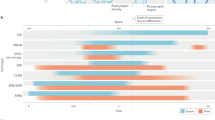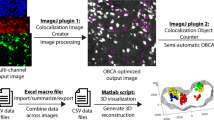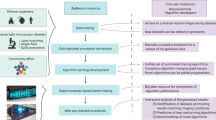Abstract
The complexity of the central nervous system calls for immunocytochemical procedures that allow target proteins to be localized with high precision and with opportunities for quantitation. Immunogold procedures stand out as particularly powerful in this regard. Although these procedures have found wide application in the neuroscience community, they present limitations and pitfalls that must be taken into account. At the same time, these procedures offer potentials that remain to be fully realized.
This is a preview of subscription content, access via your institution
Access options
Subscribe to this journal
Receive 12 print issues and online access
$209.00 per year
only $17.42 per issue
Buy this article
- Purchase on Springer Link
- Instant access to full article PDF
Prices may be subject to local taxes which are calculated during checkout








Similar content being viewed by others
References
Griffiths, G. Fine Structure Immunocytochemistry (Springer, 1993).
Maunsbach, A.B. & Afzelius, A. Biomedical Electron Microscopy: Illustrated Methods and Interpretations 1st edn. (Academic, 1999).
van den Pol, A.N. Neuronal imaging with colloidal gold. J. Microsc. 155, 27–59 (1989).
Coons, A.H., Creech, H.J. & Jones, R.N. Immunological properties of an antibody containing a fluorescent group. Proc. Soc. Exp. Biol. Med. 47, 200–202 (1941).
Hayat, M.A. Colloidal Gold: Principles, Methods, and Applications Vol. 3 (Academic, 1990).
Lorincz, A. & Nusser, Z. Specificity of immunoreactions: the importance of testing specificity in each method. J. Neurosci. 28, 9083–9086 (2008).
Saper, C.B. & Sawchenko, P.E. Magic peptides, magic antibodies: guidelines for appropriate controls for immunohistochemistry. J. Comp. Neurol. 465, 161–163 (2003).
Fritschy, J.M. Is my antibody-staining specific? How to deal with pitfalls of immunohistochemistry. Eur. J. Neurosci. 28, 2365–2370 (2008).
Pool, C.W. et al. On the way to a specific immunocytochemical localization. in Immunohistochemistry Vol. 3 (ed. Cuello, A.C.) Ch. 1, 1–46 (Wiley-Interscience, 1983).
Burry, R.W. Controls for immunocytochemistry: an update. J. Histochem. Cytochem. 59, 6–12 (2011).
Holmseth, S. et al. Specificity controls for immunocytochemistry: the antigen preadsorption test can lead to inaccurate assessment of antibody specificity. J. Histochem. Cytochem. 60, 174–187 (2012).
Rhodes, K.J. & Trimmer, J.S. Antibodies as valuable neuroscience research tools versus reagents of mass distraction. J. Neurosci. 26, 8017–8020 (2006).
Slot, J.W., Posthuma, G., Chang, L.Y., Crapo, J.D. & Geuze, H.J. Quantitative aspects of immunogold labeling in embedded and in nonembedded sections. Am. J. Anat. 185, 271–281 (1989).
Coons, A.H. Fluorescent antibodies as histochemical tools. Fed. Proc. 10, 558–559 (1951).
Faulk, W.P. & Taylor, G.M. An immunocolloid method for the electron microscope. Immunochemistry 8, 1081–1083 (1971).
Roth, J. et al. Applications of immunogold and lectin-gold labeling in tumor research and diagnosis. Histochem. Cell Biol. 106, 131–148 (1996).
Gingras, D. & Bendayan, M. Compartmentalization of secretory proteins in pancreatic zymogen granules as revealed by immunolabeling on cryo-fixed and molecular distillation processed tissue. Biol. Cell 81, 153–163 (1994).
Kharazia, V.N. & Weinberg, R.J. Immunogold localization of AMPA and NMDA receptors in somatic sensory cortex of albino rat. J. Comp. Neurol. 412, 292–302 (1999).
Sternberger, L.A. Immunocytochemistry (Wiley, 1986).
Sesack, S.R. & Snyder, C.L. Cellular and subcellular localization of syntaxin-like immunoreactivity in the rat striatum and cortex. Neuroscience 67, 993–1007 (1995).
Matsubara, A., Laake, J.H., Davanger, S., Usami, S. & Ottersen, O.P. Organization of AMPA receptor subunits at a glutamate synapse: a quantitative immunogold analysis of hair cell synapses in the rat organ of Corti. J. Neurosci. 16, 4457–4467 (1996). Defining conditions that affect the outcome of postembedding immunogold labeling.
Remacle, J., Fowler, S., Beaufay, H., Amarcostesec, A. & Berthet, J. Analytical study of microsomes and isolated subcellular membranes from rat liver. VI. Electron microscope examination of microsomes for cytochrome b5 by means of a ferritin-labeled antibody. J. Cell Biol. 71, 551–564 (1976).
Singer, S.J. Preparation of an electron-dense antibody conjugate. Nature 183, 1523–1524 (1959).
Dutton, A.H., Tokuyasu, K.T. & Singer, S.J. Iron-dextran antibody conjugates: general method for simultaneous staining of two components in high-resolution immunoelectron microscopy. Proc. Natl. Acad. Sci. USA 76, 3392–3396 (1979).
Sternberger, L.A., Donati, E.J., Cuculis, J.J. & Petrali, J.P. Indirect immunouranium technique for staining of embedded antigen in electron microscopy. Exp. Mol. Pathol. 76, 112–125 (1965).
Chan, J., Aoki, C. & Pickel, V.M. Optimization of differential immunogold-silver and peroxidase labeling with maintenance of ultrastructure in brain sections before plastic embedding. J. Neurosci. Methods 33, 113–127 (1990).
Chen, X. et al. Organization of the core structure of the postsynaptic density. Proc. Natl. Acad. Sci. USA 105, 4453–4458 (2008).
Newman, G.R. & Hobot, J.A. Resin Microscopy and On-Section Immunocytochemistry (Springer, 1993).
Ji, Z.Q., Aas, J.E., Laake, J., Walberg, F. & Ottersen, O.P. An electron microscopic, immunogold analysis of glutamate and glutamine in terminals of rat spinocerebellar fibers. J. Comp. Neurol. 307, 296–310 (1991).
Shupliakov, O., Brodin, L., Cullheim, S., Ottersen, O.P. & Storm-Mathisen, J. Immunogold quantification of glutamate in two types of excitatory synapse with different firing patterns. J. Neurosci. 12, 3789–3803 (1992).
Somogyi, P., Halasy, K., Somogyi, J., Storm-Mathisen, J. & Ottersen, O.P. Quantification of immunogold labelling reveals enrichment of glutamate in mossy and parallel fibre terminals in cat cerebellum. Neuroscience 19, 1045–1050 (1986).
Hu, H. et al. Presynaptic Ca2+-activated K+ channels in glutamatergic hippocampal terminals and their role in spike repolarization and regulation of transmitter release. J. Neurosci. 21, 9585–9597 (2001).
Landsend, A.S. et al. Differential localization of delta glutamate receptors in the rat cerebellum: coexpression with AMPA receptors in parallel fiber-spine synapses and absence from climbing fiber-spine synapses. J. Neurosci. 17, 834–842 (1997).
Takumi, Y., Ramirez-Leon, V., Laake, P., Rinvik, E. & Ottersen, O.P. Different modes of expression of AMPA and NMDA receptors in hippocampal synapses. Nat. Neurosci. 2, 618–624 (1999). Simultaneous visualization of proteins and small molecule antigens on the same section.
Valtschanoff, J.G. & Weinberg, R.J. Laminar organization of the NMDA receptor complex within the postsynaptic density. J. Neurosci. 21, 1211–1217 (2001).
Nagelhus, E.A. et al. Aquaporin-4 water channel protein in the rat retina and optic nerve: polarized expression in Muller cells and fibrous astrocytes. J. Neurosci. 18, 2506–2519 (1998).
Ganeshina, O., Berry, R.W., Petralia, R.S., Nicholson, D.A. & Geinisman, Y. Synapses with a segmented, completely partitioned postsynaptic density express more AMPA receptors than other axospinous synaptic junctions. Neuroscience 125, 615–623 (2004).
Ganeshina, O., Berry, R.W., Petralia, R.S., Nicholson, D.A. & Geinisman, Y. Differences in the expression of AMPA and NMDA receptors between axospinous perforated and nonperforated synapses are related to the configuration and size of postsynaptic densities. J. Comp. Neurol. 468, 86–95 (2004).
Bloss, E.B. et al. Morphological and molecular changes in aging rat prelimbic prefrontal cortical synapses. Neurobiol. Aging 34, 200–210 (2013).
Hara, Y. et al. Synaptic distributions of GluA2 and PKMζ in the monkey dentate gyrus and their relationships with aging and memory. J. Neurosci. 32, 7336–7344 (2012).
Posthuma, G., Slot, J.W. & Geuze, H.J. Usefulness of the immunogold technique in quantitation of a soluble protein in ultra-thin sections. J. Histochem. Cytochem. 35, 405–410 (1987).
Kraehenbuhl, J.P., Racine, L. & Griffiths, G.W. Attempts to quantitate immunocytochemistry at the electron microscope level. Histochem. J. 12, 317–332 (1980).
Blackstad, T.W., Karagulle, T. & Ottersen, O.P. MORFOREL, a computer program for two-dimensional analysis of micrographs of biological specimens, with emphasis on immunogold preparations. Comput. Biol. Med. 20, 15–34 (1990).
Ottersen, O.P., Zhang, N. & Walberg, F. Metabolic compartmentation of glutamate and glutamine: morphological evidence obtained by quantitative immunocytochemistry in rat cerebellum. Neuroscience 46, 519–534 (1992).
Ottersen, O.P. Postembedding immunogold labelling of fixed glutamate: an electron microscopic analysis of the relationship between gold particle density and antigen concentration. J. Chem. Neuroanat. 2, 57–66 (1989).
Ottersen, O.P. Postembedding light- and electron microscopic immunocytochemistry of amino acids: description of a new model system allowing identical conditions for specificity testing and tissue processing. Exp. Brain Res. 69, 167–174 (1987).
Bergersen, L.H. et al. Immunogold detection of l-glutamate and d-serine in small synaptic-like microvesicles in adult hippocampal astrocytes. Cereb. Cortex 22, 1690–1697 (2012).
Nusser, Z. et al. Cell type and pathway dependence of synaptic AMPA receptor number and variability in the hippocampus. Neuron 21, 545–559 (1998). Assessing the ratio between gold particles and number of antigens using AMPA receptors as a model.
Pradidarcheep, W., Labruyere, W.T., Dabhoiwala, N.F. & Lamers, W.H. Lack of specificity of commercially available antisera: better specifications needed. J. Histochem. Cytochem. 56, 1099–1111 (2008).
Holmseth, S., Lehre, K.P. & Danbolt, N.C. Specificity controls for immunocytochemistry. Anat. Embryol. (Berl.) 211, 257–266 (2006).
Haj-Yasein, N.N. et al. Glial-conditional deletion of aquaporin-4 (Aqp4) reduces blood-brain water uptake and confers barrier function on perivascular astrocyte endfeet. Proc. Natl. Acad. Sci. USA 108, 17815–17820 (2011).
Dale, N., Ottersen, O.P., Roberts, A. & Storm-Mathisen, J. Inhibitory neurones of a motor pattern generator in Xenopus revealed by antibodies to glycine. Nature 324, 255–257 (1986).
Storm-Mathisen, J. et al. First visualization of glutamate and GABA in neurones by immunocytochemistry. Nature 301, 517–520 (1983).
Davanger, S. et al. Colocalization of gamma-aminobutyrate and gastrin in the rat antrum: an immunocytochemical and in situ hybridization study. Gastroenterology 107, 137–148 (1994).
Amiry-Moghaddam, M. et al. An alpha-syntrophin-dependent pool of AQP4 in astroglial end-feet confers bidirectional water flow between blood and brain. Proc. Natl. Acad. Sci. USA 100, 2106–2111 (2003).
Rhodes, K.J. & Trimmer, J.S. Antibody-based validation of CNS ion channel drug targets. J. Gen. Physiol. 131, 407–413 (2008).
Jackson, A.L. & Linsley, P.S. Recognizing and avoiding siRNA off-target effects for target identification and therapeutic application. Nat. Rev. Drug Discov. 9, 57–67 (2010).
Holmseth, S. et al. Specificity of antibodies: unexpected cross-reactivity of antibodies directed against the excitatory amino acid transporter 3 (EAAT3). Neuroscience 136, 649–660 (2005).
Prasad, B.V., Burns, J.W., Marietta, E., Estes, M.K. & Chiu, W. Localization of VP4 neutralization sites in rotavirus by three-dimensional cryo-electron microscopy. Nature 343, 476–479 (1990).
Baleviciute, I., Balevicius, Z., Makaraviciute, A., Ramanaviciene, A. & Ramanavicius, A. Study of antibody/antigen binding kinetics by total internal reflection ellipsometry. Biosens. Bioelectron. 39, 170–176 (2013).
D'Amico, F. & Skarmoutsou, E. Quantifying immunogold labelling in transmission electron microscopy. J. Microsc. 230, 9–15 (2008).
Mayer, G. & Bendayan, M. Amplification methods for the immunolocalization of rare molecules in cells and tissues. Prog. Histochem. Cytochem. 36, 3–85 (2001).
Mayhew, T.M., Muhlfeld, C., Vanhecke, D. & Ochs, M. A review of recent methods for efficiently quantifying immunogold and other nanoparticles using TEM sections through cells, tissues and organs. Ann. Anat. 191, 153–170 (2009).
Sugiyama, Y., Kawabata, I., Sobue, K. & Okabe, S. Determination of absolute protein numbers in single synapses by a GFP-based calibration technique. Nat. Methods 2, 677–684 (2005).
Tønnesen, J. & Nagerl, U.V. Superresolution imaging for neuroscience. Exp. Neurol. 242, 33–40 (2013).
Maglione, M. & Sigrist, S.J. Seeing the forest tree by tree: super-resolution light microscopy meets the neurosciences. Nat. Neurosci. 16, xxx–yyy (2013).
van Lookeren Campagne, M., Oestreicher, A.B., van der Krift, T.P., Gispen, W.H. & Verkleij, A.J. Freeze-substitution and Lowicryl HM20 embedding of fixed rat brain: suitability for immunogold ultrastructural localization of neural antigens. J. Histochem. Cytochem. 39, 1267–1279 (1991).
Chaudhry, F.A. et al. Glutamate transporters in glial plasma membranes: highly differentiated localizations revealed by quantitative ultrastructural immunocytochemistry. Neuron 15, 711–720 (1995).
Franciosi, S. et al. Pepsin pretreatment allows collagen IV immunostaining of blood vessels in adult mouse brain. J. Neurosci. Methods 163, 76–82 (2007).
Alelú-Paz, R. et al. A new antigen retrieval technique for human brain tissue. PLoS ONE 3, e3378 (2008).
Watanabe, M. et al. Selective scarcity of NMDA receptor channel subunits in the stratum lucidum (mossy fibre-recipient layer) of the mouse hippocampal CA3 subfield. Eur. J. Neurosci. 10, 478–487 (1998).
Posthuma, G., Slot, J.W., Veenendaal, T. & Geuze, H.J. Immunogold determination of amylase concentrations in pancreatic subcellular compartments. Eur. J. Cell Biol. 46, 327–335 (1988).
Amiry-Moghaddam, M., Frydenlund, D.S. & Ottersen, O.P. Anchoring of aquaporin-4 in brain: molecular mechanisms and implications for the physiology and pathophysiology of water transport. Neuroscience 129, 999–1010 (2004).
Acknowledgements
We thank G. Lothe and C. Knudsen for technical assistance, P. Laake for comments, and D. Frydenlund for providing Figure 5. We gratefully acknowledge support from the Norwegian Research Council, the European Union framework programmes and the Letten Fund.
Author information
Authors and Affiliations
Corresponding author
Ethics declarations
Competing interests
The authors declare no competing financial interests.
Rights and permissions
About this article
Cite this article
Amiry-Moghaddam, M., Ottersen, O. Immunogold cytochemistry in neuroscience. Nat Neurosci 16, 798–804 (2013). https://doi.org/10.1038/nn.3418
Received:
Accepted:
Published:
Issue Date:
DOI: https://doi.org/10.1038/nn.3418
This article is cited by
-
Astrocytes mediate long-lasting synaptic regulation of ventral tegmental area dopamine neurons
Nature Neuroscience (2022)
-
Functional specialization of retinal Müller cell endfeet depends on an interplay between two syntrophin isoforms
Molecular Brain (2020)
-
Organisation of extracellular matrix proteins laminin and agrin in pericapillary basal laminae in mouse brain
Brain Structure and Function (2020)
-
Interneuron-specific signaling evokes distinctive somatostatin-mediated responses in adult cortical astrocytes
Nature Communications (2018)
-
Enhanced labeling density and whole-cell 3D dSTORM imaging by repetitive labeling of target proteins
Scientific Reports (2018)



